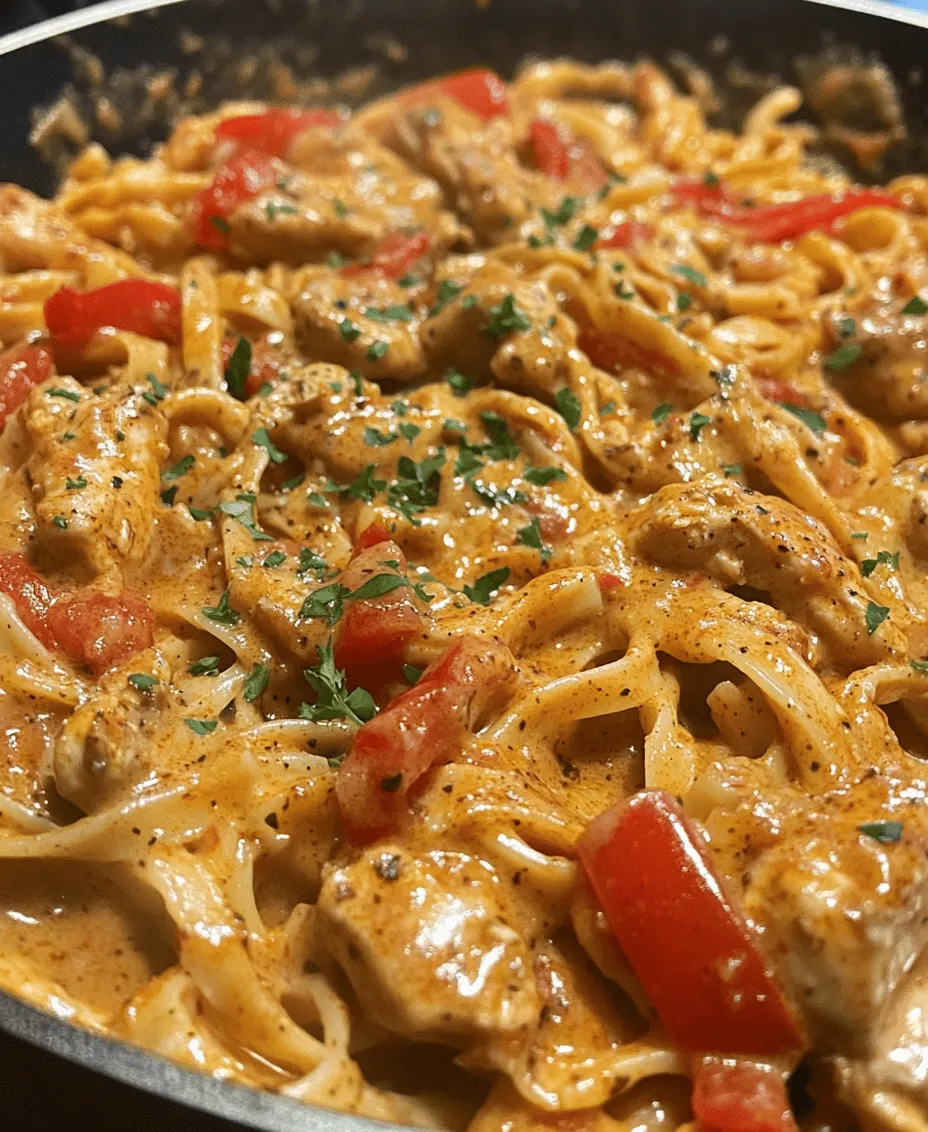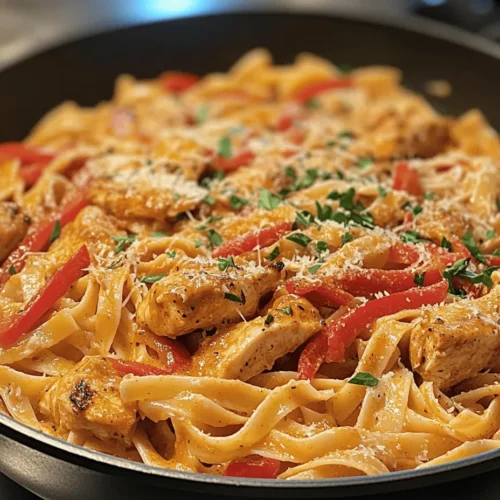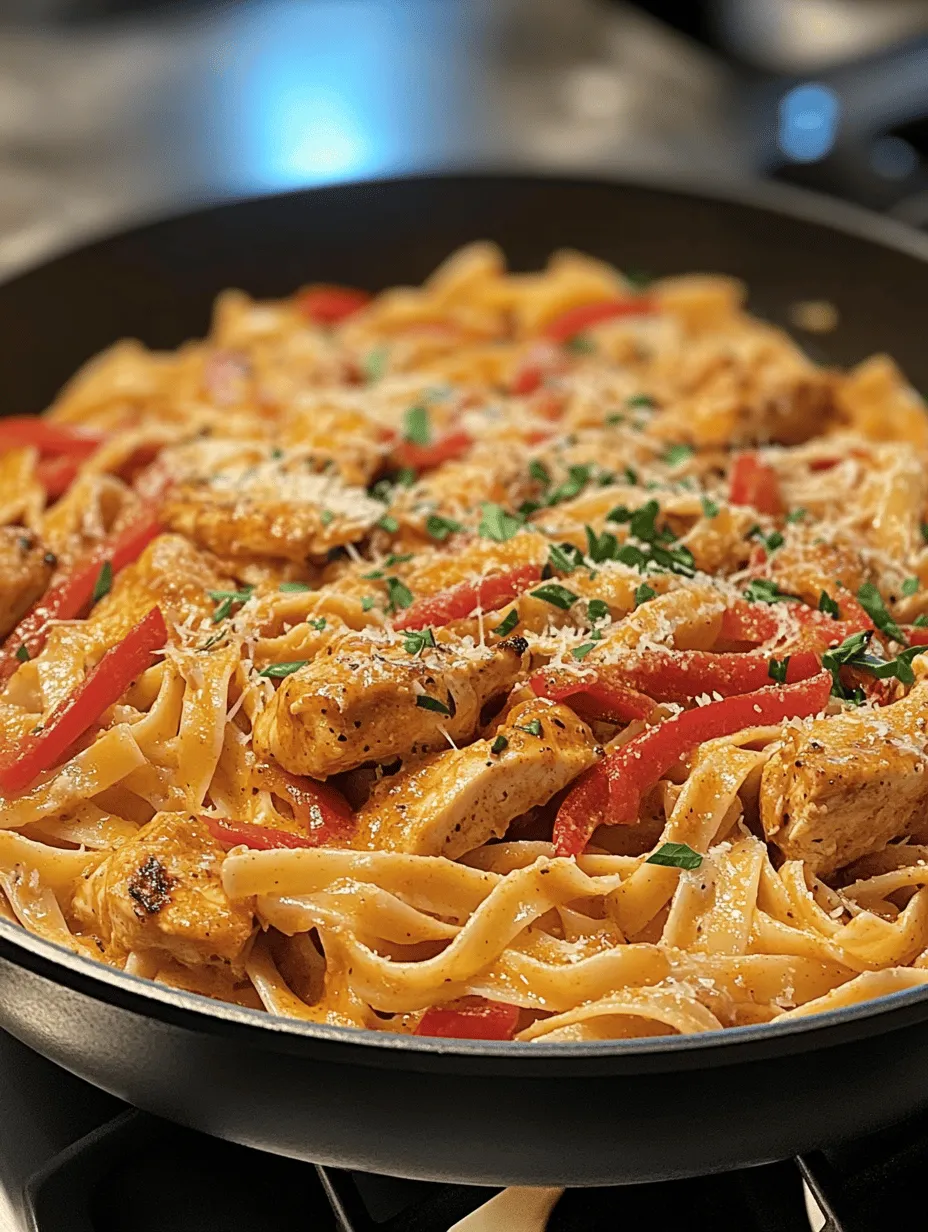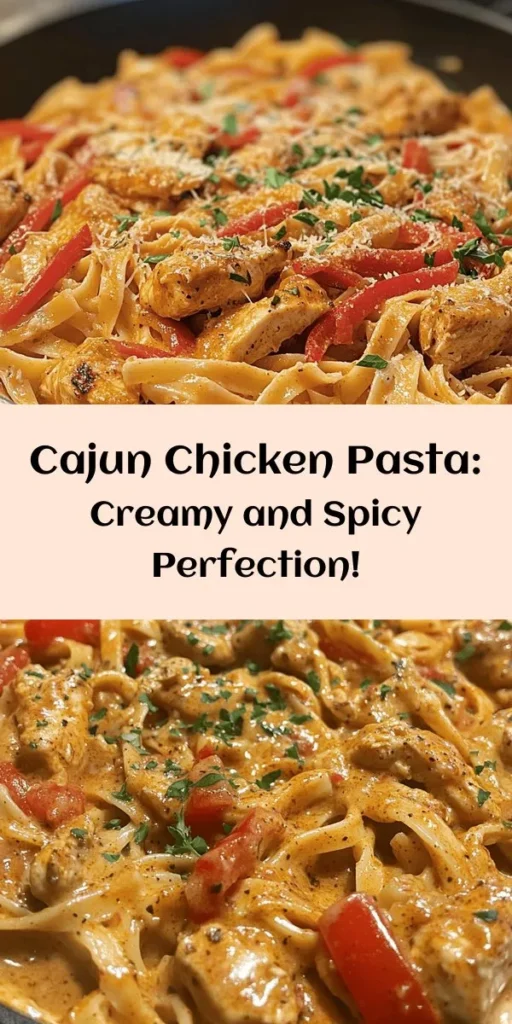Introduction
Cajun cuisine is a celebration of bold flavors and hearty ingredients, deeply rooted in the rich cultural tapestry of Louisiana. Originating from the French-speaking Acadian people who settled in the bayous of Louisiana, Cajun food is known for its vibrant spices, diverse ingredients, and comforting dishes that evoke a sense of home. Among the many delightful offerings of this culinary tradition, Spicy Creamy Cajun Chicken Pasta stands out as a perfect blend of comfort and excitement, making it an ideal choice for both weeknight dinners and special occasions.
This dish encapsulates the essence of Cajun cooking, combining tender chicken with a creamy, spicy sauce that clings to every piece of pasta. It’s a meal that not only satisfies hunger but also tantalizes the taste buds with its rich flavors and aromatic spices. For home cooking enthusiasts, having easy-to-follow recipes like this one is essential for creating restaurant-quality dishes right in your kitchen. With just a few simple steps, you can whip up a plate of Spicy Creamy Cajun Chicken Pasta that will impress your family and friends alike.
Understanding Cajun Cuisine
Historical Background of Cajun Food
Cajun cuisine has a storied history that reflects the cultural influences of the French, Spanish, African, and Native American communities in Louisiana. The term “Cajun” derives from “Acadian,” referring to the descendants of French settlers exiled from Canada in the 18th century. As these settlers adapted to their new environment, they developed a unique culinary style that utilized local ingredients and traditional cooking techniques.
The cuisine is characterized by its emphasis on fresh, seasonal produce, hearty proteins, and a variety of spices. Traditional Cajun dishes often include staples like rice, seafood, and game meats, showcasing the resourcefulness of the Cajun people in utilizing what was available to them. Over time, Cajun cooking has gained popularity beyond Louisiana, finding its way into kitchens across the globe, celebrated for its robust flavors and comforting nature.
Key Ingredients Commonly Used in Cajun Dishes
At the heart of Cajun cooking are its key ingredients, which provide depth and character to its dishes. Some of the most commonly used components include:
– Holy Trinity: The cornerstone of many Cajun recipes, this trio consists of onions, bell peppers, and celery. These vegetables form the flavorful base for countless dishes, adding sweetness and complexity.
– Spices: Cajun cuisine is renowned for its bold spice blends, often featuring paprika, cayenne pepper, garlic powder, onion powder, and black pepper. These spices are essential for achieving the signature heat and flavor that defines Cajun dishes.
– Proteins: Chicken, sausage, and seafood are frequently featured in Cajun recipes. The choice of protein can significantly influence the dish’s flavor and texture, making it crucial to select high-quality ingredients.
– Rice and Pasta: While rice is a staple side in many Cajun meals, pasta has become increasingly popular, especially in dishes like Spicy Creamy Cajun Chicken Pasta. The choice between different pasta types can enhance the overall eating experience.
The Role of Spices and Seasonings in Enhancing Flavor Profiles
Spices and seasonings are the lifeblood of Cajun cuisine, transforming simple ingredients into unforgettable meals. The careful balance of spices not only adds heat but also layers of flavor that make each bite a culinary adventure. Cajun cooking often embraces the philosophy of “if a little is good, more is better,” leading to generously seasoned dishes that pack a punch.
For those who are sensitive to spice, it’s important to understand that the heat can be adjusted according to personal preference. The beauty of Cajun cooking lies in its flexibility, allowing cooks to tailor their dishes to suit their tastes while still honoring the fundamental flavors of the cuisine.
Ingredients Breakdown
Creating Spicy Creamy Cajun Chicken Pasta requires a selection of fresh and flavorful ingredients that come together to create a harmonious dish. Below, we break down each ingredient, highlighting its role in the recipe and the importance of quality in achieving the best results.
Detailed Description of Each Ingredient
– Chicken: Boneless, skinless chicken breasts are the preferred choice for this recipe due to their lean nature and ability to absorb flavors. Chicken thighs can also be used for a richer taste. The chicken is usually seasoned with a blend of Cajun spices to infuse it with bold flavors.
– Pasta: While fettuccine is commonly used for its ability to hold creamy sauces, penne can also be a great choice for those who prefer a different texture. The shape of the pasta can significantly impact the overall mouthfeel of the dish, with each bite delivering a satisfying combination of sauce and pasta.
– Heavy Cream: This ingredient is essential for creating the creamy sauce that envelops the pasta and chicken. It adds richness and smoothness, balancing out the heat from the spices. For a lighter version, half-and-half or a non-dairy alternative can be used, though it may alter the dish’s overall creaminess.
– Chicken Broth: Using low-sodium chicken broth enhances the flavor of the sauce without overpowering it. It adds depth and moisture to the dish, allowing it to be both hearty and flavorful.
– Bell Peppers: A mix of red, green, and yellow bell peppers not only adds vibrant color to the dish but also a subtle sweetness that complements the spices. These vegetables are a key component of the Holy Trinity in Cajun cooking and contribute to the overall texture and flavor.
– Garlic: Fresh garlic is a must-have for its aromatic qualities. It provides a savory foundation for the sauce and enhances the dish’s overall flavor profile.
– Cajun Seasoning: This spice blend is the star of the show, typically containing paprika, cayenne pepper, oregano, thyme, and garlic powder. It can be adjusted according to individual heat preferences, making it a versatile seasoning that can be tailored to taste.
The Significance of Pasta Choice
The choice of pasta can significantly impact the final dish. Fettuccine, with its wide, flat shape, is excellent for capturing the creamy sauce, ensuring that every bite is rich and flavorful. On the other hand, penne, with its tubular shape, provides a delightful bite and can hold onto the sauce in its crevices, offering a different yet equally satisfying experience. Ultimately, the choice between fettuccine and penne comes down to personal preference; both options are delicious and will provide a comforting base for the spicy Cajun chicken.
Importance of Fresh Ingredients
Using fresh ingredients is crucial in Cajun cooking as they elevate the overall taste and quality of the dish. Fresh bell peppers, for example, add a crunch and sweetness that dried or frozen vegetables simply cannot replicate. Similarly, fresh garlic provides a punchy flavor that is essential for the sauce’s base. The quality of the chicken also plays a significant role, as fresh, high-quality meat yields better flavor and texture than its frozen counterparts.
Insight into the Role of Heavy Cream and Chicken Broth
Heavy cream and chicken broth are key players in achieving the luscious, creamy sauce that defines this dish. Heavy cream enriches the sauce, adding a velvety texture that coats the pasta and chicken beautifully. It balances the spiciness of the Cajun seasoning, creating a harmonious flavor profile that pleases the palate.
Chicken broth, on the other hand, adds depth and enhances the overall flavor without overwhelming the dish. Together, these two ingredients work in tandem to create a sauce that is both rich and comforting, perfect for a cozy dinner at home.
Step-by-Step Cooking Instructions
Cooking the Pasta: Techniques for Perfect Al Dente Pasta
To begin your culinary journey with Spicy Creamy Cajun Chicken Pasta, the first step is to cook the pasta. A key to achieving the perfect texture is to ensure that the pasta is cooked al dente, meaning it should be firm to the bite but not hard. Here’s how to do it:
1. Boil Water: Start by bringing a large pot of salted water to a rolling boil. The salt is essential as it enhances the flavor of the pasta. Use about one tablespoon of salt for every gallon of water.
2. Add Pasta: Once the water is boiling, add your choice of pasta and stir occasionally to prevent sticking. Follow the package instructions for cooking time, but start checking for doneness a minute or two early.
3. Reserve Pasta Water: Before draining the pasta, be sure to reserve about a cup of the starchy pasta water. This water is a valuable addition to the sauce, helping to achieve the desired consistency.
4. Drain and Set Aside: Drain the pasta in a colander and set it aside. Avoid rinsing it, as this removes the starch that helps the sauce adhere to the pasta.
Seasoning the Chicken: Understanding the Balance of Cajun Seasoning
While the pasta cooks, it’s time to focus on the chicken. Properly seasoning the chicken is essential for infusing it with the bold flavors characteristic of Cajun cuisine. Here’s how to do it:
1. Pat Chicken Dry: Start by patting the chicken breasts dry with paper towels. This helps the seasoning adhere better and allows for a nice sear during cooking.
2. Season Generously: Liberally sprinkle Cajun seasoning over both sides of the chicken. The amount can be adjusted based on your spice tolerance; if you prefer a milder flavor, use less seasoning.
3. Consider Marinating: For an extra flavor boost, consider marinating the chicken for about 15-30 minutes. This brief marination allows the spices to penetrate the meat, enhancing the overall taste.
Sautéing the Chicken: Best Practices for Achieving a Golden-Brown Crust
Once the chicken is seasoned, it’s time to sauté it to perfection. Proper cooking techniques will ensure that your chicken is juicy and flavorful while achieving a beautiful golden-brown crust.
1. Heat the Pan: In a large skillet, heat a couple of tablespoons of oil over medium-high heat until shimmering. The oil should be hot enough to sear the chicken without burning.
2. Cook in Batches: To achieve even browning, avoid overcrowding the pan. Cook the chicken in batches if necessary, allowing each piece enough space to sear properly. This method prevents steaming and ensures a nice crust.
3. Monitor Cooking Time: Sauté the chicken for about 5-7 minutes on each side, depending on thickness. It’s important to cook until the internal temperature reaches 165°F (75°C) for food safety.
4. Remove and Rest: Once cooked, remove the chicken from the pan and let it rest for a few minutes before slicing. This resting period allows the juices to redistribute, resulting in a tender and juicy bite.
By following these step-by-step instructions and understanding the importance of each ingredient, you are well on your way to creating a delicious Spicy Creamy Cajun Chicken Pasta. The combination of bold spices, creamy sauce, and perfectly cooked pasta will transport you to the heart of Louisiana with every savory bite.

How to Avoid Overcrowding the Skillet
When it comes to sautéing your chicken and vegetables for the Spicy Creamy Cajun Chicken Pasta, one crucial tip is to avoid overcrowding the skillet. Overcrowding can lead to steaming rather than browning, which means you’ll miss out on the delicious caramelization that enhances the flavor profile of your dish. To prevent this, cook your chicken in batches if necessary. Aim for a single layer of chicken in the skillet, allowing each piece enough space to develop a golden-brown crust. This technique not only elevates the taste but also ensures that the chicken remains juicy and tender.
Sautéing the Vegetables: Flavor Development Through Sautéing
Once your chicken is cooked, it’s time to sauté the vegetables. Start by adding a splash of olive oil or butter to the skillet, followed by diced onions and minced garlic. Sautéing these aromatics is essential as they form the flavor base of your dish. Cook them until the onions become translucent and the garlic is fragrant, usually about 2-3 minutes. This step releases their natural sugars, enhancing the overall depth of flavor in your pasta.
The Importance of Onion and Garlic as Flavor Bases
Onion and garlic are culinary staples for a reason. They not only add flavor but also serve as a foundation for building complexity in your dish. The sweetness of the onion and the pungent, aromatic qualities of garlic complement the spicy Cajun seasoning, contributing to a well-rounded flavor profile. Skipping these ingredients would result in a significant loss of taste, so be sure to include them when making your sauce.
Tips for Ensuring Vegetables Retain Their Texture
To ensure your vegetables retain their crunch and don’t become mushy, cook them over medium-high heat and avoid overcooking. Aim for a slight firmness in your bell peppers and any other vegetables you choose to include, such as zucchini or mushrooms. Adding them to the skillet after the onions and garlic will help them cook evenly without losing their texture. Stir occasionally and keep an eye on them; they should be bright and colorful, signaling that they are cooked just right.
Making the Sauce: Techniques for Combining Cream and Broth
After your vegetables have sautéed to perfection, it’s time to create the sauce. Start by adding your Cajun seasoning to the skillet, stirring it into the vegetable mixture to toast the spices slightly. This step helps to intensify their flavors. Next, pour in your chicken broth, scraping up any browned bits from the bottom of the skillet—this adds extra flavor to your sauce. Once the broth is simmering, slowly stir in heavy cream. The combination of broth and cream creates a rich, luscious sauce that coats the pasta beautifully.
Explanation of Simmering and Thickening Processes
Simmering is a key technique in creating a flavorful sauce. After you’ve added the cream, reduce the heat to medium-low and let the mixture simmer gently. This allows the flavors to meld together and the sauce to thicken. Stir occasionally to prevent it from sticking to the bottom of the skillet. If the sauce seems too thin, continue to simmer it for a few more minutes until it reaches your desired consistency.
How to Achieve the Right Sauce Consistency and Balance Flavors
To achieve the right sauce consistency, you will want it to be thick enough to cling to the pasta but not so thick that it becomes gluey. If necessary, adjust the thickness by adding more broth or cream until you achieve the desired texture. Additionally, taste the sauce as it simmers and adjust the seasoning if needed. A pinch of salt, freshly cracked black pepper, or a bit more Cajun seasoning can help balance out the flavors.
Combining Everything: Ensuring Even Distribution of Sauce and Chicken
Once your sauce is ready, it’s time to combine everything. Add your cooked pasta directly into the skillet along with the sautéed chicken. Gently toss everything together to ensure the pasta is evenly coated in the creamy sauce. This is also the moment to incorporate any additional ingredients you might like, such as spinach or sun-dried tomatoes, for added flavor and nutrition.
Tips for Tossing Pasta, Chicken, and Sauce Effectively
When tossing pasta with the sauce, it’s essential to use a combination of gentle folding and stirring motions to avoid breaking the pasta. Use a pair of tongs or a large fork to lift and turn the ingredients together in the skillet. This technique will help ensure that every strand of pasta is coated in that spicy, creamy goodness without damaging the texture.
Importance of Adding Reserved Pasta Water Gradually
A great tip to enhance your dish is to reserve some of the pasta cooking water before draining. This starchy water can be added gradually to the sauce if it seems too thick. The starch helps to bind the sauce to the pasta, creating a silky texture. Start with a few tablespoons, stirring it in until you reach the desired consistency.
Final Seasoning and Garnishing: Enhancing Flavors Before Serving
Before serving, take a moment to taste your dish one last time. Adjust the seasoning as necessary, adding salt, pepper, or a little more Cajun seasoning if desired. For a fresh finishing touch, sprinkle chopped parsley over the top. This not only adds a pop of color but also a hint of freshness that balances the richness of the creamy sauce.
Serving Suggestions
To serve your Spicy Creamy Cajun Chicken Pasta, consider pairing it with sides that complement the dish’s flavors. A simple green salad with a tangy vinaigrette can provide a refreshing contrast to the richness of the pasta. For a heartier option, crusty garlic bread is a delightful accompaniment that can help soak up any remaining sauce.
Presentation plays a key role in enhancing your dining experience. Serve your pasta in a shallow bowl, twirling the noodles for an elegant look. Drizzle a little extra sauce over the top and finish with a sprinkle of fresh parsley and a few cracks of black pepper for visual appeal.
If you have dietary restrictions, don’t hesitate to experiment with variations or substitutions. For gluten-free options, use gluten-free pasta; for a lighter version, consider swapping out heavy cream for a lighter alternative, such as coconut milk or cashew cream. You can also substitute chicken with shrimp or tofu for a different protein source that fits your dietary needs.
Storage and Reheating Tips
If you find yourself with leftovers (which is unlikely, given how delicious this dish is), proper storage is essential. Allow the pasta to cool completely before transferring it to an airtight container. Store it in the refrigerator for up to three days.
When reheating, the stovetop is your best friend. Add a splash of chicken broth or water to the skillet to help loosen the sauce and prevent it from drying out. Heat gently over low heat, stirring frequently until warmed through. Avoid microwaving, as this can lead to uneven heating and a change in texture.
Conclusion
The Spicy Creamy Cajun Chicken Pasta is a delightful dish that brings together rich flavors, creamy textures, and a satisfying kick of spice. With its versatility, you can easily adapt it to cater to various tastes and dietary preferences. The joy of creating this dish lies not only in the cooking process but also in the comfort it brings to the table.
We encourage you to experiment with Cajun flavors in your everyday cooking, infusing your meals with the warmth and excitement that this cuisine offers. Each bite of this homemade pasta is a reminder of how simple ingredients can come together to create something truly remarkable. Embrace the joy of cooking and enjoy the delicious results of your culinary endeavors!



